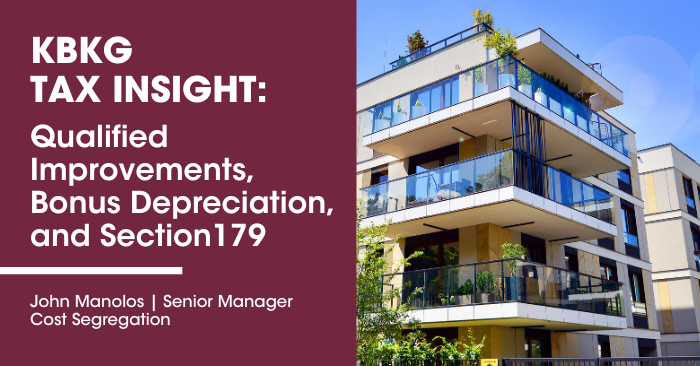KBKG Tax Insight: Qualified Improvements, Bonus Depreciation, and 179
By John Manolos | Senior Manager - Cost Segregation
With the passage of the CARES Act on March 27, 2020, Congress addressed the much anticipated “Retail Glitch” associated with the 2017 Tax Cuts and Jobs Act (TCJA). This rule previously prevented investments in qualified improvement property (QIP) from qualifying for bonus depreciation. The recovery period for QIP is now reduced from 39 years to 15 years, thus making it eligible for 100 percent bonus depreciation through 2022. This change is retroactive to January 1, 2018. The KBKG Qualified Improvements Depreciation Quick Reference Chart has been updated accordingly.
KBKG Insight: An automatic accounting method change (i.e. Form 3115) can be used to retroactively claim missed QIP, 179, and bonus depreciation deductions. The corresponding Section 481(a) adjustment must also be calculated and inserted into the form.
Background
The CARES Act slightly changed the definition of Qualified Improvement Property by adding language indicating the improvement must be made by the taxpayer.
Qualified Improvement Property is defined as any improvement made by the taxpayer to an interior portion of a building that is nonresidential real property as long as that improvement is placed in service after the building was first placed in service by any taxpayer (Section 168(k)(3)). QIP specifically excludes expenditures for (1) the enlargement of a building; , (2) elevators or escalators; , and (3) the internal structural framework of a building.
Another potential deduction is utilizing Section 179. A taxpayer can elect to recover all or part of the cost of certain qualifying property, up to a limit, by deducting it in the year it is placed in service. Electing 179 can potentially recover the entire cost of business property in the first year in lieu of recovering the cost via depreciation.
Unfortunately, the total amount a taxpayer can elect to expense under 179 is contingent upon a maximum dollar limit, investment limit, and business income limit. By law, the maximum deduction and investment limit are indexed for inflation.
From 2018 onward, the Section 179 expense includes improvements to the following nonresidential real property that are placed in service after the date such property was first placed in service: roofs; heating, ventilation, and air-conditioning; fire protection and alarm systems; and security systems.
Qualified Section 179 property now includes depreciable tangible personal property used to furnish lodging (e.g. residential rental properties, hotels, etc.).
Conclusion
There are several methods available to taxpayers to maximize their depreciation deductions. By identifying shorter-life property via a cost segregation study, this strategy provides accelerated depreciation expenses, which are eligible for the special bonus depreciation allowance.
Section 179 is another option capable of immediate write-offs if taxpayers meet certain eligibility requirements. Please double-check if there are any federal / state conformity issues.
Finally, for 2023, the bonus rate is 80%. The rate decreases by 20% every year through 2026, when bonus completely sunsets unless Congress amends the current statute.
John Manolos | Senior Manager – Cost Segregation
John Manolos is a senior manager in KBKG’s Pasadena and Woodland Hills offices and a member of the Firm’s National Tax Practice. With over 15 years of tax experience, he specializes in fixed asset consulting including Cost Segregation studies, repair and maintenance expense analyses, and other tax advisory services specific to cost recovery in the real estate industry. Read More..




